Vitamin B6 deficient plants display increased sensitivity to high light and photo-oxidative stress
- PMID: 19903353
- PMCID: PMC2777905
- DOI: 10.1186/1471-2229-9-130
Vitamin B6 deficient plants display increased sensitivity to high light and photo-oxidative stress
Abstract
Background: Vitamin B6 is a collective term for a group of six interconvertible compounds: pyridoxine, pyridoxal, pyridoxamine and their phosphorylated derivatives. Vitamin B6 plays essential roles as a cofactor in a range of biochemical reactions. In addition, vitamin B6 is able to quench reactive oxygen species in vitro, and exogenously applied vitamin B6 protects plant cells against cell death induced by singlet oxygen (1O2). These results raise the important question as to whether plants employ vitamin B6 as an antioxidant to protect themselves against reactive oxygen species.
Results: The pdx1.3 mutation affects the vitamin B6 biosynthesis enzyme, pyridoxal synthase (PDX1), and leads to a reduction of the vitamin B6 concentration in Arabidopsis thaliana leaves. Although leaves of the pdx1.3 Arabidopsis mutant contained less chlorophyll than wild-type leaves, we found that vitamin B6 deficiency did not significantly impact photosynthetic performance or shoot and root growth. Chlorophyll loss was associated with an increase in the chlorophyll a/b ratio and a selective decrease in the abundance of several PSII antenna proteins (Lhcb1/2, Lhcb6). These changes were strongly dependent on light intensity, with high light amplifying the difference between pdx1.3 and the wild type. When leaf discs were exposed to exogenous 1O2, lipid peroxidation in pdx1.3 was increased relative to the wild type; this effect was not observed with superoxide or hydrogen peroxide. When leaf discs or whole plants were exposed to excess light energy, 1O2-mediated lipid peroxidation was enhanced in leaves of the pdx1.3 mutant relative to the wild type. High light also caused an increased level of 1O2 in vitamin B6-deficient leaves. Combining the pdx1.3 mutation with mutations affecting the level of 'classical' quenchers of 1O2 (zeaxanthin, tocopherols) resulted in a highly photosensitive phenotype.
Conclusion: This study demonstrates that vitamin B6 has a function in the in vivo antioxidant defense of plants. Thus, the antioxidant activity of vitamin B6 inferred from in vitro studies is confirmed in planta. Together with the finding that chloroplasts contain vitamin B6 compounds, the data show that vitamin B6 functions as a photoprotector that limits 1O2 accumulation in high light and prevents 1O2-mediated oxidative damage.
Figures
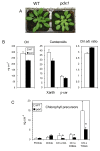


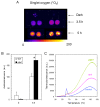


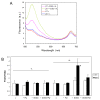
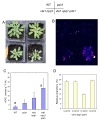
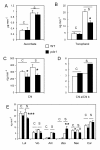
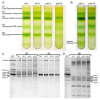
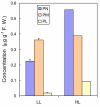
Similar articles
-
Pyridoxine is required for post-embryonic root development and tolerance to osmotic and oxidative stresses.Plant J. 2005 Nov;44(3):396-408. doi: 10.1111/j.1365-313X.2005.02538.x. Plant J. 2005. PMID: 16236150
-
The role of the pyridoxine (vitamin B6) biosynthesis enzyme PDX1 in ultraviolet-B radiation responses in plants.Plant Physiol Biochem. 2011 Mar;49(3):284-92. doi: 10.1016/j.plaphy.2011.01.003. Epub 2011 Jan 12. Plant Physiol Biochem. 2011. PMID: 21288732
-
Analysis of the Arabidopsis rsr4-1/pdx1-3 mutant reveals the critical function of the PDX1 protein family in metabolism, development, and vitamin B6 biosynthesis.Plant Cell. 2006 Jul;18(7):1722-35. doi: 10.1105/tpc.105.036269. Epub 2006 Jun 9. Plant Cell. 2006. PMID: 16766694 Free PMC article.
-
Vitamin B6: a molecule for human health?Molecules. 2010 Jan 20;15(1):442-59. doi: 10.3390/molecules15010442. Molecules. 2010. PMID: 20110903 Free PMC article. Review.
-
Review: the effect of light on the key pigment compounds of photosensitive etiolated tea plant.Bot Stud. 2021 Dec 11;62(1):21. doi: 10.1186/s40529-021-00329-2. Bot Stud. 2021. PMID: 34897570 Free PMC article. Review.
Cited by
-
Transcriptomic Insights into Molecular Response of Butter Lettuce to Different Light Wavelengths.Plants (Basel). 2024 Jun 7;13(12):1582. doi: 10.3390/plants13121582. Plants (Basel). 2024. PMID: 38931014 Free PMC article.
-
Vitamin B₆ and Its Role in Cell Metabolism and Physiology.Cells. 2018 Jul 22;7(7):84. doi: 10.3390/cells7070084. Cells. 2018. PMID: 30037155 Free PMC article. Review.
-
Metatranscriptomic and metabolite profiling reveals vertical heterogeneity within a Zygnema green algal mat from Svalbard (High Arctic).Environ Microbiol. 2019 Nov;21(11):4283-4299. doi: 10.1111/1462-2920.14788. Epub 2019 Sep 11. Environ Microbiol. 2019. PMID: 31454446 Free PMC article.
-
Antioxidants in Potatoes: A Functional View on One of the Major Food Crops Worldwide.Molecules. 2021 Apr 22;26(9):2446. doi: 10.3390/molecules26092446. Molecules. 2021. PMID: 33922183 Free PMC article. Review.
-
Chloroplast lipid droplet type II NAD(P)H quinone oxidoreductase is essential for prenylquinone metabolism and vitamin K1 accumulation.Proc Natl Acad Sci U S A. 2011 Aug 23;108(34):14354-9. doi: 10.1073/pnas.1104790108. Epub 2011 Aug 15. Proc Natl Acad Sci U S A. 2011. PMID: 21844348 Free PMC article.
References
MeSH terms
Substances
LinkOut - more resources
Full Text Sources
Medical
Molecular Biology Databases

